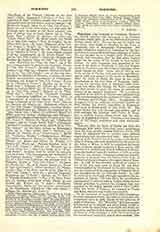

Commines (also COMINES or COMYNES), PHILIPPE DE, French historian and statesman, b. in Flanders probably before 1447; d. at the Chateau d’Argenton, France, about 1511. He was the son of Colard van den Clyte, chief bailiff of Flanders for the Duke of Burgundy, and of Marguerite d’Armuyden. His family owned the seigniory of Commines on the Lys, and some of his ancestors had been aldermen of Ypres. He was brought up as a knight, spoke Flemish and French, but complains that he had never learned Latin—in the course of his travels he had learned Italian. In 1464 Commines was presented at the court of the Duke of Burgundy in Lille and became squire to the duke’s son, the Count of Charolais, afterwards Charles the Bold. From 1464 to 1472 he was in the service of Charles, took part in his expeditions, and in 1465 was present at the battle of Montlhery. After the death of Philip the Good he was made chamberlain to the new Duke of Burgundy (1467). During the interview held at Peronne (1468) Corn-mines was taken into Charles the Bold’s confidence and then turned to Louis XI whom he secretly informed of his master’s intentions. He nevertheless remained in the service of Charles who entrusted him with various missions to the governor of Calais (1470), to Brittany, and to Spain (1471). Nevertheless, on August 8, 1472, he suddenly abandoned Charles the Bold during the duke’s expedition in Normandy and went to Ponts-de-Ce to join Louis XI. The latter loaded him with favors and estates, and in 1473 arranged his marriage with Helene de Chambes, a wealthy heiress whose dowry was the seigniory of Argenton in Poitou. Commines now became one of the king’s confidants and chief diplomatic agents.
However, after the death of Charles the Bold, the frankness with which Commines urged moderation upon the king aroused passing disfavor, but in 1478 Louis XI appointed him to conduct some difficult negotiations with the princes of Italy. After the conspiracy of the Pazzi he saved the power of the Medici, allies of France, who were threatened by the pope and the dukes of Milan; in 1479 he protected the young Duke of Savoy against Lodovico it Moro, and in 1481 succeeded in maintaining French influence in Savoy. Upon the death of Louis XI, however, in 1.183, at which event he was present, Commines permitted himself, however, to be drawn into the faction of the Duke of Orleans and conspired against the regent, Anne of Beaujeu. In 1487 he was arrested, confined at Loches in one of the iron cages used by Louis XI, and afterwards banished by Parliament to his own estates; he was also deprived of his principality of Talmont which was reclaimed by the La Tremoille family. In 1491 he returned to court and, although opposed to the expedition of Charles VIII into Italy, he nevertheless accompanied it and was sent to Venice, where he was utterly powerless to prevent the intrigues that culminated in the league against Charles VIII (1495). After the battle of Fornovo, he returned to Venice and Milan, where he was totally unsuccessful.
On the accession of Louis XII in 1498, Commines, for some unknown reason, lost caste at court and only reappeared there in 1505, thanks to the influence of Anne of Brittany. His “Memoires” give but meager information as to himself and leave many points in doubt; even the exact dates of his birth and death are uncertain, and but little is known of the part he played at Peronne, of his defection in 1472, his retirement at the accession of Louis XII, and of other matters. The “Memoires” constitute a political history of Europe from 1464 to 1498 and, according to the preface, are material intended exclusively for the use of Angelo Cato, Archbishop of Vienne, who was to write a Latin history of Louis XI. The first part of the work, dealing with the period between 1464 and 1483, was prepared between 1489 and 1491, that containing the account of the reign of Charles VIII being completed in 1498. Commines is rather analytic than graphic, devotes himself more to ascertaining the causes of events than to describing the events themselves; his language seems inferior to his thought and his style is abrupt and periphrastic. The thought bears the impress of the realistic politics of the Renaissance, but the manner of expression is still medieval. The work has been preserved in manuscript and in sixteenth-century editions, the first edition being that of Galliot du Pre (Paris, 1524, fol.). A manuscript, written about 1530, and recovered by de Mandrot, is the only one containing the complete text. The chief editions are those of Mlle Dupont in the publications of the Societe de l’Histoire de France (Paris, 1847, 3 vols.), Chantelauze (Paris, 1881), and de Mandrot (Paris, 1903, 2 vols.). Commines’ tomb, on which is a kneeling figure of him and also one of his wife, Helene de Chambes, is preserved in the Louvre.
LOUIS BREHIER

